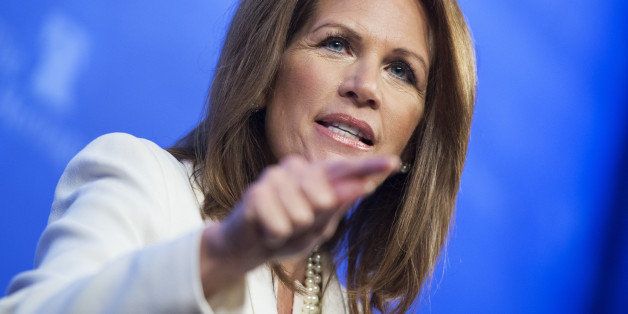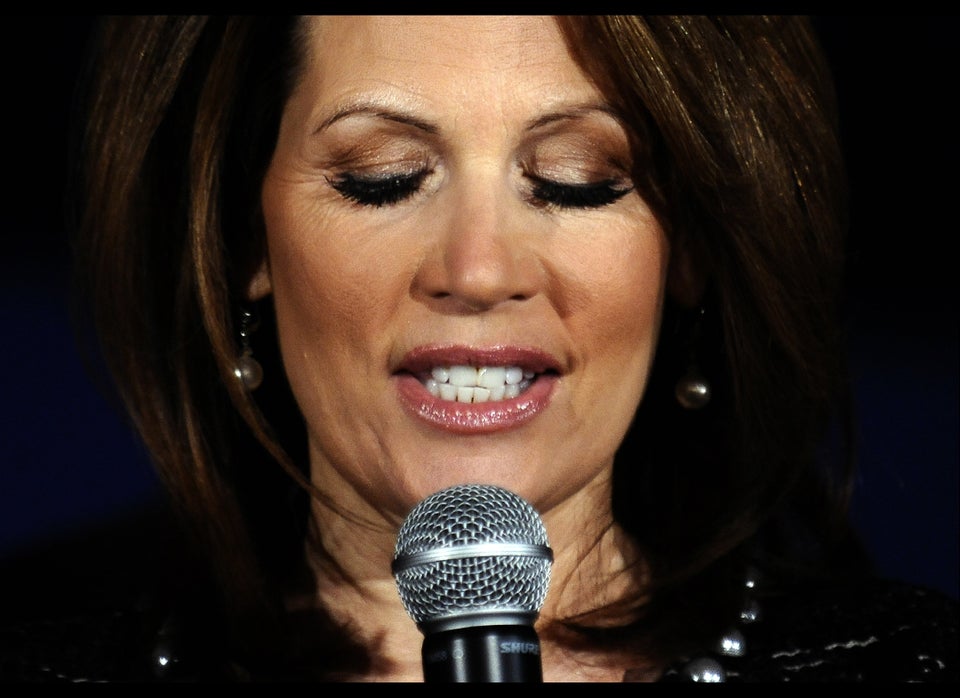

The following post first appeared on FactCheck.org.
In the latest round of what’s-happening-to-health-care-premiums, Republican Rep. Michele Bachmann wrongly claims that we’re seeing “huge increases” in employer-sponsored plans, while President Obama touts historically low health care inflation, which experts say is mainly due to the slow economy, not the health care law.
Both Bachmann and Obama were making competing arguments about the success of the Affordable Care Act, specifically on costs to consumers.
We’ll start with Bachmann, who made her comments on Fox News’ “On the Record” on Nov. 17.
Bachmann: We are seeing huge increases in these premiums, not only in the Obamacare exchanges, but in the private market. Because remember, a lot of times it’s the private market where we are getting health care through our employers. It’s the private market that has to offset government programs, whether its Medicaid or whatever government program. So the costs are going through the roof.
Her comment that there have been “huge increases” in the private market “where we are getting health care through our employers” is low-hanging fruit for fact-checkers. Employer-sponsored insurance premiums have been growing at low rates for the past several years. The average annual family-plan premium went up 3 percent from 2013 to 2014, according to the latest annual employer survey from the nonprofit Kaiser Family Foundation and Health Research & Educational Trust.
As the press release on the survey says: “Premiums increased more slowly over the past five years than the preceding five years (26 percent vs. 34 percent) and well below the annual double-digit increases recorded in the late 1990s and early 2000s. This year’s increase also is similar to the year-to-year rise in worker’s wages (2.3 percent) and general inflation (2 percent).”
We’ve explained before that a small increase in employer-sponsored premiums from 2010 to 2011 was linked to the Affordable Care Act’s elimination of preexisting condition exclusions for children, coverage of dependents on their parents’ plans up to age 26, free coverage of preventive care, and an increase in caps on annual coverage. At the time, experts estimated premiums had increased 1 percent to 3 percent due to those requirements.
Despite that, there has been a slow rate of growth for premiums for the 48 percent of Americans on employer plans recently.
While premiums have gone up slowly, deductibles also have increased. The percentage of covered workers on plans with a deductible was 63 percent in 2009 and had increased to 80 percent in 2014.
As we’ll explain, it’s unclear how much the Affordable Care Act has affected this slow growth of premiums. But, at any rate, it’s clear Bachmann is wrong when she says there have been “huge increases” and “costs are going through the roof.”
The president, meanwhile, talked about the growth of health care costs in a press conference on Nov. 16 in Brisbane, Australia, site of the G20 summit.
Obama: And contrary to some of the predictions of the naysayers, not only is the program working, but we’ve actually seen health care inflation lower than it’s been in 50 years, which is contributing to us reducing the deficit, and has the effect of making premiums for families lower that they otherwise would have been if they have health insurance.
Obama is right about health care inflation, or health care costs, and it’s a statistic the administration has cited several times. From 2009 to 2012, total health care expenditures for the U.S. have grown at rates under 4 percent per year (see Table 23). The journal Health Affairs noted that such rates are the lowest since the National Health Expenditure Accounts data was first compiled in 1960 by the Centers for Medicare & Medicaid Services. The NHEA estimates total health care spending in the country.
But Obama implies that the ACA caused that slow growth, and experts say it’s mainly due to the slow economy. A 2013 statistical analysis of health spending by the Kaiser Family Foundation determined that “much of the decline in health spending growth in recent years was fully expected given what was happening more broadly in the economy.” The analysis estimated that “about three-quarters (77%) of the recent decline in health spending growth can be explained by changes in the broader economy.”
Similarly, experts at CMS said in a January article in Health Affairs that the health care law had a “minimal impact” on the slowdown. They wrote that the major reasons were the economy and its slow recovery, increased use of lower-cost generic prescription drugs, and a reduction in Medicare payments to skilled nursing facilities.
The ACA may have had some influence. Drew Altman, CEO of KFF, explained in a September 2013 column that the law may be having an indirect effect, though it’s difficult to prove. Altman wrote: “Historically, we have always seen the health-care marketplace respond by lowering costs when there is the threat of impending health reform legislation or government action on costs. Now we have not only the threat but the reality.”
The White House Council of Economic Advisers also issued a report in November 2013 saying the ACA is a “meaningful” contributor to the slowdown in spending, even if it’s not the sole or most important factor. The CEA said that the law’s reductions in Medicare spending would not only have an impact on slowing growth in Medicare but would have a “spillover effect” on overall health care spending.
So, the ACA may be a factor in the historically low growth in health care spending in recent years, but it’s certainly not the sole reason. CMS projects continued slow growth in total spending in 2013 “due to the modest economic recovery, the impacts of sequestration and continued slow growth in the utilization of Medicare services, and continued increases in cost-sharing requirements for the privately insured.”
But after that, the rate of growth is expected to increase, partly due to an increase in the number of insured individuals under the ACA. CMS projects average growth of 6 percent per year for 2015 through 2023, “largely as a result of the continued implementation of the ACA coverage expansions, faster projected economic growth, and the aging of the population.”
Obamacare Premiums
Bachmann also mentioned “huge increases” in premiums on the “Obamacare exchanges.” Are premiums on the state and federal marketplaces going up significantly? Overall, no, but some individuals face substantial increases unless they are willing to switch plans.
The New York Times analyzed the recent premium rate data on the marketplace plans released by the federal government and found that many with existing marketplace plans could see increases, as high as 20 percent, on their current plans. But it pays to shop around. “In a typical county, the price will rise 5 percent for the cheapest silver plan and 4 percent for the second cheapest,” the Times wrote.
The Times also looked at data from the McKinsey Center for U.S. Health System Reform and found that the premium for the cheapest Silver plan is 3.4 percent higher for 2015, compared with last year. But if consumers stayed put in the cheapest plan from 2014, they would see an average increase of 9.7 percent. In other words, the cheapest plan from 2014 is, in many cases, not the cheapest in 2015.
An interactive map created by the Times shows how the increases — and even decreases — in premiums vary widely across the country. Those renewing the cheapest Silver plan would see a drop in premiums in Maine, New Hampshire, New Mexico and most of Mississippi, as well as a few other areas across the country. But a much greater proportion of the country would see a decrease in premiums if consumers switched plans.
Similarly, the Kaiser Family Foundation’s analysis of HealthCare.gov data and state insurance rate filings found low overall increases in premiums on average — but geographic variation. For all U.S. counties, the second-cheapest Silver plan is up by 2 percent on average and the cheapest Bronze plan is up by 4 percent, KFF found.
The nonprofit also looked at rates in 51 cities in the U.S., and the change in the second-cheapest Silver plan for a 40-year-old nonsmoker. Premiums for those plans are going up by just 2.5 percent in Birmingham, Alabama, but up by 28.4 percent in Anchorage, Alaska, and down by 10 percent in Phoenix, Arizona. The biggest discrepancy is between those Anchorage rates and a 25.5 percent drop in premiums in Jackson, Mississippi.
It remains to be seen to what extent consumers will shop around for lower-cost plans. In the past, the individual market has experienced a lot of turnover, with some of those purchasing their own insurance doing so for only short periods of time. It also was a market that saw substantial premium increases. In 2010, the last year KFF surveyed people in the individual market about premiums, it found that more than three-quarters of consumers reported that their insurers had requested a premium increase of 20 percent on average.
Most who faced a premium increase elected to stay with the plan anyway. But 16 percent of all those on the individual market switched plans and ended up paying 3 percent less on average than they had before. That group also may have been motivated by more substantial price increases — KFF’s survey found the plan-switchers had faced an average premium increase of 31 percent.
That market was also one in which consumers could be denied coverage, or charged higher rates, for preexisting health conditions. Insurers are no longer allowed to deny coverage or base premiums on health status, so there’s no longer that risk in shopping around.
An FAQ on the KFF website explains that it’s important to at least update one’s application for tax credit purposes; those subsidies are based on family income and also the cost of benchmark exchange plans. In most cases if an application isn’t updated by Dec. 15, the tax credit will automatically continue and the plan will be renewed.
One last thing: Bachmann went on to say that “President Obama promised us that our health insurance premiums would reduce $2,500 a year. Put your hand up if your health care premiums reduced $2,500 a year. No one’s did.” We’ve long questioned this old claim from Obama, calling it “overly optimistic” and “misleading” when he first posited on the campaign trail in 2008 that a shift to electronic medical records would lead to such savings.
Though he didn’t make it clear, Obama was talking about a reduction in spending compared with what would have happened in the absence of the law — or a slower growth. And he was counting trickle-down savings in the form of lower taxes and higher wages.
In the years since, we’ve shot down other White House versions of the $2,500 claim.
